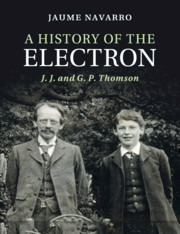Refine search
Actions for selected content:
10306 results in History of science: general interest
10 - Two Cultures
- from Part III - Science and politics
-
- Book:
- Science, Democracy, and the American University
- Published online:
- 05 November 2012
- Print publication:
- 29 October 2012, pp 302-334
-
- Chapter
- Export citation
Part III - Science and politics
-
- Book:
- Science, Democracy, and the American University
- Published online:
- 05 November 2012
- Print publication:
- 29 October 2012, pp 225-374
-
- Chapter
- Export citation
Contents
-
- Book:
- Science, Democracy, and the American University
- Published online:
- 05 November 2012
- Print publication:
- 29 October 2012, pp v-vi
-
- Chapter
- Export citation
To make Florida answer to its name: John Ellis, Bernard Romans and the Atlantic science of British West Florida
-
- Journal:
- The British Journal for the History of Science / Volume 47 / Issue 1 / March 2014
- Published online by Cambridge University Press:
- 23 October 2012, pp. 43-65
- Print publication:
- March 2014
-
- Article
- Export citation
Experimental physiology, Everest and oxygen: from the ghastly kitchens to the gasping lung
-
- Journal:
- The British Journal for the History of Science / Volume 46 / Issue 1 / March 2013
- Published online by Cambridge University Press:
- 12 October 2012, pp. 123-147
- Print publication:
- March 2013
-
- Article
-
- You have access
- Open access
- HTML
- Export citation

A History of the Electron
- J. J. and G. P. Thomson
-
- Published online:
- 05 October 2012
- Print publication:
- 06 September 2012
Aepyornis as moa: giant birds and global connections in nineteenth-century science
-
- Journal:
- The British Journal for the History of Science / Volume 46 / Issue 4 / December 2013
- Published online by Cambridge University Press:
- 25 September 2012, pp. 675-693
- Print publication:
- December 2013
-
- Article
- Export citation
Systems of display: the making of anatomical knowledge in Enlightenment Britain
-
- Journal:
- The British Journal for the History of Science / Volume 46 / Issue 3 / September 2013
- Published online by Cambridge University Press:
- 12 September 2012, pp. 359-387
- Print publication:
- September 2013
-
- Article
- Export citation
References
-
- Book:
- A History of the Electron
- Published online:
- 05 October 2012
- Print publication:
- 06 September 2012, pp 171-182
-
- Chapter
- Export citation
2 - J. J. Thomson’s early work in Cambridge:
-
- Book:
- A History of the Electron
- Published online:
- 05 October 2012
- Print publication:
- 06 September 2012, pp 29-54
-
- Chapter
- Export citation
Introduction
-
- Book:
- A History of the Electron
- Published online:
- 05 October 2012
- Print publication:
- 06 September 2012, pp 1-5
-
- Chapter
- Export citation
A History of the Electron - Title page
-
-
- Book:
- A History of the Electron
- Published online:
- 05 October 2012
- Print publication:
- 06 September 2012, pp iii-iii
-
- Chapter
- Export citation
Dedication
-
- Book:
- A History of the Electron
- Published online:
- 05 October 2012
- Print publication:
- 06 September 2012, pp v-vi
-
- Chapter
- Export citation
1 - The early years in Manchester and Cambridge
-
- Book:
- A History of the Electron
- Published online:
- 05 October 2012
- Print publication:
- 06 September 2012, pp 6-28
-
- Chapter
- Export citation
6 - The electron in Aberdeen:
-
- Book:
- A History of the Electron
- Published online:
- 05 October 2012
- Print publication:
- 06 September 2012, pp 143-170
-
- Chapter
- Export citation
5 - Father and son. Old and new physics
-
- Book:
- A History of the Electron
- Published online:
- 05 October 2012
- Print publication:
- 06 September 2012, pp 114-142
-
- Chapter
- Export citation
A History of the Electron - Half title page
-
- Book:
- A History of the Electron
- Published online:
- 05 October 2012
- Print publication:
- 06 September 2012, pp i-ii
-
- Chapter
- Export citation
4 - On creeds and policies:
-
- Book:
- A History of the Electron
- Published online:
- 05 October 2012
- Print publication:
- 06 September 2012, pp 86-113
-
- Chapter
- Export citation
Index
-
- Book:
- A History of the Electron
- Published online:
- 05 October 2012
- Print publication:
- 06 September 2012, pp 183-186
-
- Chapter
- Export citation
Copyright page
-
- Book:
- A History of the Electron
- Published online:
- 05 October 2012
- Print publication:
- 06 September 2012, pp iv-iv
-
- Chapter
- Export citation
